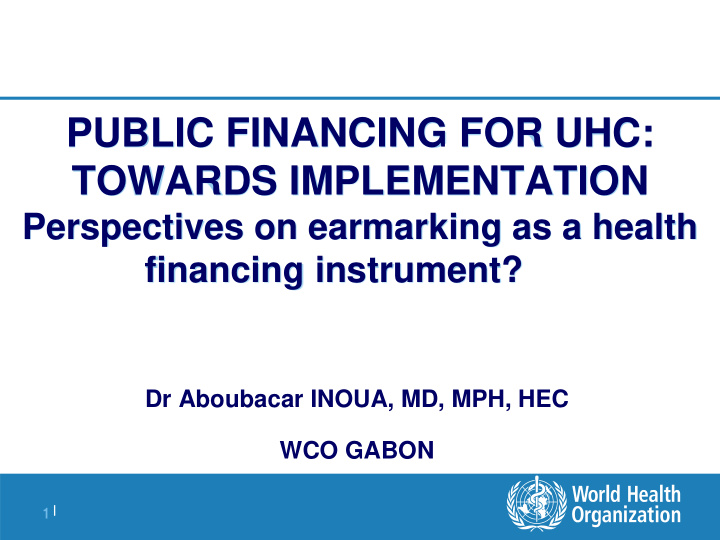



PUBLIC FINANCING FOR UHC: TOWARDS IMPLEMENTATION Perspectives on earmarking as a health financing instrument? Dr Aboubacar INOUA, MD, MPH, HEC WCO GABON 1 |
CNAMGS experience in earmarking 2 |
SESSION OUTLINE Context Objectives Choice & creation of the « Redevance Obligatoire l’Assurance Maladie » (ROAM) Impacts & limits of the ROAM Creation of the “Contribution Spéciale de Solidarité” Bottlenecks Conclusion 3 |
CONTEXT 30% of the population living below the poverty line; Bankruptcy of the insurance system designed to poor people; 20% of the population benefits from health insurance; General Government Health Expenditure : 7% of GGE; Out Of Pocket Expenditure : 47% of DTS; DTS: 3% of GDP ; Low performance of the health system; Low health indicators : RMM, TMM5, HIV/AIDS… 4 |
Objectives Provide health insurance to the poor people: Ensure financial accessibility to quality care for the population, especially the poorest; Reduce Out Of Pocket Expenditure. Identify additional income and earmarking to the health of the poor; Ensure equity in financial contributions; Improve the management of financial resources in the health sector. 5 |
Choice & creation of the ROAM (1) Sufficient resources STABILITY & EQUITY PREDICTABILITY Criteria for choosing taxes Low impact on EFFICIENCY the consumption 6 |
Choice & creation of the ROAM (2) Taxe under Negociations Withheld taxes review • Employer hostility Tax on mobile • Mistrust from unions • Tobacco & Alchool phones • Resistance from • Airline tickets private insurers • Hydrocarbons and ( Expanding Sectors, luxury products) • Pressure from mining Tax on financial unions fighting • Mobile phones transactions (country against poverty • Financial with strong immigration) transactions 7 |
Choice & creation of the ROAM (3) Act n°0022/PR/2007 of 21 August 2007, establishment of the health insurance ; ROAM indirect tax is composed of: Tax of 10% of turnover on mobile phone companies; Tax of 1.5% on remittances abroad (outside the CEMAC zone) and foreign exchange transactions.. Liability, base tax and rates set by the Finance Act; ROAM is deductable from Personal Income Tax and Corporate Tax. 8 |
Impact of the ROAM Dépenses Totales de Extension of health Santé (DTS) 350,000,000,000 Régimes de l'administration publique coverage to the poor Régimes contributifs obligatoires ROAM 300,000,000,000 people (700 000 people); 250,000,000,000 Increase on DTS; 200,000,000,000 Increased GGEH ; 150,000,000,000 Decline of Out Of Pocket 100,000,000,000 Expenditure; 50,000,000,000 Fungibility of funds or 0 2010 2011 2012 2013 2014 2015 economic crisis ? 9 |
Limits of the ROAM 30 BILLION 25 R² = 0.8462 R² = 0.88 20 15 10 ROAM et TTF 5 Total dépenses Log. (ROAM et TTF) Linear (Total dépenses) 0 2009 2010 2011 2012 2013 2014 2015 2016 2017 10 |
Special Contribution for Solidarity (CSS) Remove of the tax on mobile telephony in 2017 : Economic crisis and employer pressure; Stagnation of income from ROAM; Reduced profit margin made by mobile phone companies.. CSS: 1% of the tax free amount applicable to all invoices for goods and services provided countrywide; Tax on consumption in line with VAT; Increase ROAM's income to meet the health care costs of the poor. 11 |
Bottlenecks Resistance of targeted economic operators; Heavy administrative burden for tax collection procedures; Involvement of several administrations in the tax management; Non-involvement of CNAMGS in the tax settlement; Delays, by the public treasury, to reverse the revenue; Absence of control over the frequency of payments; Absence of the pooling with other ressources. 12 |
Conclusion Political leadership ; Strong health financing Strong partnership between instrument; MOF and MOH Increase DTS, GGHE ; Tax base financing (ROAM) Reduction of OOP (20%); is a political instrument ; Increase providers resources; 90% of the poor covered ; Improved tax collection; Accountability: Largest pooling of resources; National Health Account (NHA) Control of health insurance Public Expenditure Review (PER) expenditure; Quality of service? Strategic purchasing; People satisfaction? Inefficiency of expenditure 13 |
Recommend
More recommend